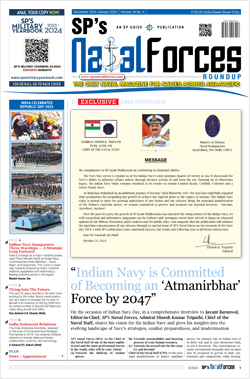INDIAN ARMED FORCES CHIEFS ON OUR RELENTLESS AND FOCUSED PUBLISHING EFFORTS

The insightful articles, inspiring narrations and analytical perspectives presented by the Editorial Team, establish an alluring connect with the reader. My compliments and best wishes to SP Guide Publications.

"Over the past 60 years, the growth of SP Guide Publications has mirrored the rising stature of Indian Navy. Its well-researched and informative magazines on Defence and Aerospace sector have served to shape an educated opinion of our military personnel, policy makers and the public alike. I wish SP's Publication team continued success, fair winds and following seas in all future endeavour!"

Since, its inception in 1964, SP Guide Publications has consistently demonstrated commitment to high-quality journalism in the aerospace and defence sectors, earning a well-deserved reputation as Asia's largest media house in this domain. I wish SP Guide Publications continued success in its pursuit of excellence.
- MoD initiates comprehensive review of Defence Acquisition Procedure 2020, pushes for defence reforms
- G7: The Swansong
- Kalinga Connect: South Asia to Polynesia
- Advanced MRSAM for India for a greater firepower
- Must Credit DRDO for Operation Sindoor, now what is next for defence R&D?
- Operation Sindoor | Day 2 DGMOs Briefing
- Operation Sindoor: Resolute yet Restrained
$3 billion deal for lease of 2nd Russian Akula class N-submarine for Indian Navy
Chakra-III to be delivered to Indian Navy by 2025

India and Russia are reported to have signed an Inter-Governmental Agreement on March 7 in New Delhi for the lease of a second Russian Akula class nuclear-powered attack submarine (SSN) for the Indian Navy for 10 years for an estimated $3 Billion.
While there's no official confirmation from either side, it has been widely reported that the submarine will be delivered to the Indian Navy by 2025.

This submarine has been referred to in media reports as the Chakra-III, alluding to two previous lease agreements between India and Russia for nuclear-powered submarines. The first, Chakra-I was a Charlie class submarine leased to India from 1988 to 1991. The second, an Akula-class Chakra-II, is currently in service with the Indian Navy on a 10-year lease with effect from 2012.
Reports also suggest a parallel agreement to extend the lease of the Chakra-II by five years.
The second Akula on lease is expected to test bed Indian-made command and control systems, communication equipment and sensors in preparation for India's own SSN programme. It is also important for continuation in training of naval crews to operate nuclear submarines.
These lease agreements are significant both in terms of underwater sea denial capability, and also for the learning curve for India's indigenous programme to build six SSNs.
The second Akula on lease is expected to test bed Indian-made command and control systems, communication equipment and sensors in preparation for India's own SSN programme. It is also important for continuation in training of naval crews to operate nuclear submarines.
The lease deal caps a very successful year for Russia in India's arms market. The other highlights were multi-billion dollar deals for S-400 Triumf air defence systems, four follow-on Krivak class frigates and the production of at least 650,000 AK-203 assault rifles in India. All these deals are through the government-to-government route, and have taken place despite the shadow of the American CAATSA legislation which seeks to curb international trade with American rivals like Russia and Iran.
The lease deal caps a very successful year for Russia in India's arms market. The other highlights were multi-billion dollar deals for S-400 Triumf air defence systems, four follow-on Krivak class frigates and the production of at least 650,000 AK-203 assault rifles in India. All these deals are through the government-to-government route, and have taken place despite the shadow of the American CAATSA legislation which seeks to curb international trade with American rivals like Russia and Iran.
The hull for the second Akula class submarine to be leased to India has been shipped for completion to the Severodvinsk shipyard. Indians are likely to gain valuable expertise in the project, which also involves fitment of important Indian-built systems, in the run up to the construction of SSNs in India.
The SSNs are powered by nuclear reactors but armed with conventional weapons. These can remain submerged for long periods unlike conventionally powered diesel-electric submarines which need to surface regularly to recharge batteries. Long submergence makes SSNs difficult to detect, thus making these potent sea denial weapons. Nuclear propulsion also make attack submarines much faster.
The Russian Akulas are among the world's most advanced SSNs. The lease of the Akulas prepares India to shore up its naval strength in its maritime backyard at a time when China's PLA Navy is making rapid inroads into the Indian Ocean Region.





